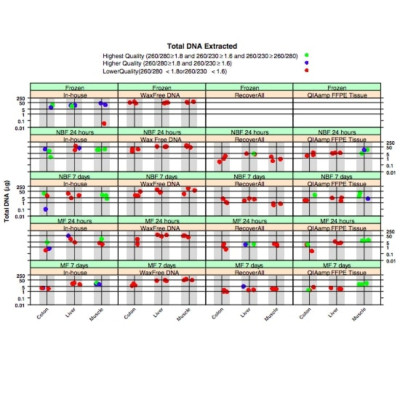Abstract
Although the extraction and analysis of nucleic acids from formalin-fixed paraffin-embedded tissues is a routine and growing part of pathology practice, no generally accepted recommendations exist to guide laboratories in their selection of tissue fixation, processing and DNA/RNA extraction techniques. The aim of this study was to determine how fixation method and length, paraffin embedding, processing conditions and nucleic acid extraction methods affect quality and quantity of DNA and RNA, and their performance in downstream applications. Nine tissue samples were subjected to freezing, fixation in formalin for <24 h and 7 days followed by conventional processing, and fixation in molecular fixative for <24 h and 7 days followed by rapid processing. DNA and RNA were isolated using in-house extraction and commercial kits, and assessed by PCR reactions for amplicons with varying sizes ranging from 268 to 1327 bp and one-step RT-PCR for 621 bp and 816 bp amplicons of housekeeping genes. Molecular fixative (MF) appeared to perform well under nearly all circumstances (extraction methods, fixation lengths and longer amplicons), often performing as well as frozen samples. Formalin fixation generally performed well only for shorter length amplicons and short fixation (<24 h). WaxFree kit showed consistently higher success rates for DNA and poorer rates for RNA. RecoverAll kit generally performed suboptimally in combination with prolonged formalin fixation. In conclusion, the Molecular Fixative regardless of fixation length, and the rapid tissue processing system were able to preserve large DNA and RNA fragments in paraffin blocks, making these techniques preferable for use in downstream molecular diagnostic assays.
